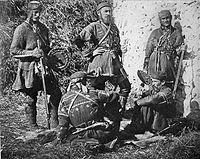Khevsurians
ხევსურები | |
|---|---|
 Khevsurians in traditional dress (apr. 1900) | |
| Regions with significant populations | |
| Khevsureti (Georgia) | |
| Languages | |
| Georgian | |
| Religion | |
| Christianity (Georgian Orthodox) | |
| Related ethnic groups | |
| Tushetians |
Khevsurians (Georgian: ხევსურები) are an ethnographic group of Georgians, mainly living in Khevsureti, on both sides of the Caucasus Mountain Chain in the watersheds of the rivers Aragvi and Argun. There are some villages in Khevi, Ertso-Tianeti, Kakheti (Shiraki), Kvemo Kartli (Gardabani) also where Khevsurians reside. Khevsurians speak the Georgian language in Khevsurian dialect. For a long time, Khevsurians have maintained their traditional culture: clothing, weapons, and polyphonic music.[1]
History

Khevsurians first are mentioned in the 10th-century manuscripts. In 1745 they were described by Vakhushti Bagrationi in his work Description of the Kingdom of Georgia.
In the old Georgian chronicle, Khevsureti and Pshavi are referred to together as "Pkhovi", while the Pshavians and Khevsurians themselves were called "Pkhoveli". This is evidenced by the reference of Vakhushti. He says in the description of the north-eastern part of Heret-Kakheti: "But they are called Pshav Khevsur, who previously were called Pkhoelni".
The Kists bordering Khevsureti still call Khevsureti "Pkhia" or "Pkhye", which means the same as "Pkhoeli".
Anthropologically, Khevsurians have a slim, east Georgian type of face; due to harsh living conditions in mountain areas, many of them are thin. Khevsurians generally have light colored eyes and hair color ranging from blonde to black.
In Autumn of 1811, the Khevsurians and Ingush joined the uprising that broke out in the region of Kakheti led by the fugitive Georgian prince (eristavi) Alexander.[2][3]
References
- ^ Большая советская энциклопедия. Гл. ред. Б. А. Введенский, 2-е изд. Т. 46. Фусе — Цуруга. 1957. 672 стр., илл. и карты; 48 л. илл. и карт.
- ^ Джабаги 1953.
- ^ Далгат 2008, p. 53.
Bibliography
- Далгат, Б. К. (2008). Тишков, В. А.; Куделин, А. Б.; Гацак, В. М. (eds.). Родовой быт и обычное право чеченцев и ингушей. Исследование и материалы 1892-1894 гг. [Tribal life and customary law of the Chechens and Ingush. Research and materials of 1892-1894] (in Russian). Москва: ИМЛИ РАН. pp. 1–382. ISBN 978-5-9208-0307-8.
- Джабаги, В.-Г. (June 1953). "Падение Грузии и Закавказских ханств (к 170-летию Георгиевского трактата)" [The fall of Georgia and the Transcaucasian Khanates (to the 170th anniversary of the Treaty of Georgievsk)]. DerFreieKaukasus (in Russian). 6 (21). Münhen.
Further reading
- Sherman, R. (2021). "Kicking the Crusaders out of the Caucasus: Deconstructing the 200-Year-Old Meme that the Khevsurs Descended from a Lost Band of Medieval Knights." Nationalities Papers, 49(1), 54–71.
